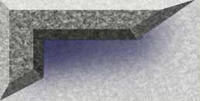尽忠 - Chugi - Loyalty
A Brief History of Samurai 
Japan has a history that dates back thousands of years. Scientists believe the Japanese people descended from
many groups that migrated to the islands from other parts of Asia, including China and Korea. As early as 4500 B.C., the Japanese
islands were inhabited by fishermen, hunters and farmers. The early culture was known as "Jomon," which meant "cord pattern."
That's because the people made pottery decorated with rope-like designs. Scientists believe a caucasian race called the "Ainu"
were the first inhabitants of what is now Japan. The Ainu still exist today, mostly in the northernmost islands of Japan called
"Hokkaido." The next major Japanese cultural changed occured about 200 B.C. The people were known as "Yayoi." The Yayoi were
mostly farmers. Scientists believe the present-day Japanese closely resemble the Yayoi in appearance and language.
War played a central part in the history of Japan. Warring clans controlled much of the country. A chief headed
each clan; made up of related families. The chiefs were the ancestors of Japan's imperial family. The wars were usually about
"land." Only 20% of the land was fit for farming. The struggle for control of that land eventually gave rise to the Samurai.

One of the important dates in the history of the Japanese warring class is 660 B.C. That's when, according
to legend, Jimmu Tenno became head of a confederation of warlike clans. Tenno was known as "The Divine Warrior." He led his
people from Kyushu to the Kinki region and conquered the people there. Tenno settled in the area of Yamato. This eventually
gave rise to the Yamato dynasty and state. The leaders of Yamato believed themselves to be of divine origin. 
The Yamato clans conducted many military campaigns on the Asian mainland. The targets included Korea and China.
These campaigns led to the importation of Korean and Chinese culture, technology and martial arts.
Legend says that Emperor Keiko was the first person with the title of "Shogun." The word meant "Barbarian-subduing
General." Legend continues that Keiko had a son named "Prince Yamato." He was cunning, fearless, strong and a great martial
artist. Many believe that Yamato was a role model for future Samurai.
Ancient Yayoi warriors developed weapons, armour and a code during the ensuing centuries that became the centerpiece
for the Japanese Samurai. Early weapons included bows, arrows and swords. Armour included a helmet that protected head and
neck, a breasplate that protected the chest, arm and shoulder protectors, and a belly wrap. Later armour included protection
for the legs and thighs. Armour changed as the type of battles changed. A big change occured in the 5th century when horses
were introduced to Japan. Another change occured in the 15th century because of the constancy of war and the introduction
of guns into battle. The code developed from the Chinese concept of the virtues of warriors doing battle to the Samurai code
of chivalry known as Kyuba no michi ("The Way of Horse and Bow") to the Bushido ("Way of the Warrior") code.

"Bushido" means "Way of the Warrior." It was at the heart of the beliefs and conduct of the Samurai. The philosophy
of Bushido is "freedom from fear." It meant that the Samurai transcended his fear of death. That gave him the peace and power
to serve his master faithfully and loyally and die well if necessary. "Duty" is a primary philosophy of the Samurai.
The Samurai rose out of the continuing battles for land among three main clans: the Minamoto, the Fujiwara
and the Taira. The Samurai eventually became a class unto themselves between the 9th and 12th centuries A.D. They were called
by two names: Samurai (knights-retainers) and Bushi (warriors). Some of them were related to the ruling class. Others were
hired men. They gave complete loyalty to their Daimyo (feudal landowners) and received land and position in return. Each Daimyo
used his Samurai to protect his land and to expand his power and rights to more land.
The Samurai became expert in fighting from horseback and on the ground. They practiced armed and un-armed
combat. The early Samurai emphasized fighting with the bow and arrow. They used swords for close-in fighting and beheading
their enemies. Battles with the Mongols in the late 13th century led to a change in the Samurai's fighting style. They began
to use their sword more and also made more use of spears and naginata. The Samurai slowly changed from fighting on horseback
to fighting on foot. 
The Samurai wore two swords (daisho). One was long; the other short. The long sword (daito - katana) was more
than 24 inches. The short sword (shoto - wakizashi) was between 12 and 24 inches. The Samurai often gave names to their swords
and believed it was the "soul" of their warriorship. The oldest swords were straight and had their early design in Korea and
China. The Samurai's desire for tougher, sharper swords for battle gave rise to the curved blade we still have today. The
sword had its beginning as iron combined with carbon. The swordsmith used fire, water, anvil and hammer to shape the world's
best swords. After forging the blade, the sword polisher did his work to prepare the blade for the "furniture" that surrounded
it. Next, the sword tester took the new blade and cut through the bodies of corpses or condemned criminals. They started by
cutting through the small bones of the body and moved up to the large bones. Test results were often recorded on the nakago
(the metal piece attaching the sword blade to the handle). 










FLASH

